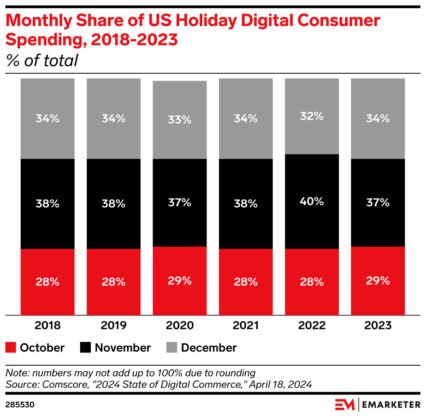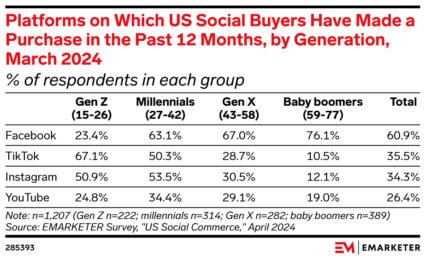Eliza Brashares, Darren D’Altorio, Marina Golden, Calvin Nichols, Matt Stinnett, and Eduardo Suarez contributed to this blog.
The biggest shopping week of the year is coming up fast, and 2024 is promising to be an interesting season for marketers: inflation is still impacting shopping decisions, the aftermath of the election is still fresh in consumers’ minds, and, if that wasn’t enough, the holiday season is even shorter than usual.
Shoppers are also trying some new things when making holiday purchases this year, from AI shopping assistants to buy-now-pay-later (BNPL) services.
White Paper
Your Changing Customer: Retail Media, Social Commerce, & Media Convergence
To beat the competition, your brand needs to eliminate siloed thinking and put a full-funnel, integrated strategy in place to connect with audiences and convince them to convert—wherever they’re exploring or purchasing.

But never fear: as an early present, our experts are breaking down our predictions for next week and the rest of Q4, so your brand can get back to enjoying the holiday cheer (and profits).
There are optimistic signs around the 2024 holiday consumer climate
Many retailers are feeling (cautiously) optimistic about spending this holiday season, and for good reason: across all categories, spending is forecasted to increase by 4.8%, according to eMarketer. That follows an upward trend from last year when spend was up 3.8% from 2022.

Source: eMarketer
But that doesn’t mean everything is sunshine and daisies this BFCM. American shoppers are still feeling the reverberations of a contentious 2024 presidential election, which may lead many to look forward to totally disconnecting from social media and the news during the holiday season–even more than usual. However, while elections generally bring a small dip in holiday shopping, consumption usually bounces back quickly after the event.
To top it all off, this already fast-paced time of year will fly by even quicker than usual in 2024. The holiday shopping season overall is five days shorter than last year, which is major for such a critical buying time.
There are just 27 days in the essential period between Thanksgiving and Christmas Day this year. Hanukkah also starts on Christmas Day and Kwanzaa kicks off on December 26th.
Fewer holiday shopping days mean less time to ship holiday purchases–so anticipate more last-minute shopping in person after consumers hit shipping constraints. That partially accounts for the projected acceleration of physical retail sales, surpassing $1 trillion for the third consecutive year per eMarketer. Those sales are forecasted to rise 3.7% year-over-year (YoY) during the holiday period, outpacing the 1.8% growth we’ve seen for 2024 overall.
Ecommerce will also see major spend this holiday season, with a 9.5% increase YoY in 2024, and will account for nearly 20% of all holiday purchases. Apparel and electronics will continue to be the dominant categories in holiday ecommerce sales, while food and beverage, health and personal care, and apparel are expected to drive the most growth ecommerce growth YoY.
The consumer calendar shifts earlier, but BFCM still packs a punch
For years, the holiday shopping calendar has been shifting, with the season moving earlier into October and even September. Early spending is a major factor for holiday planning for many brands, especially among younger consumers: Gen Z shoppers in particular are willing to spend slightly more to get their holiday items earlier.
Higher-income shoppers are also likelier to make purchases early, likely because they have the financial wiggle room to plan ahead. Google found that 34% of American consumers had already begun holiday research and shopping by July.

Source: eMarketer
But that doesn’t mean Q4 has lost its power. Most holiday shopping still happens during the crucial holiday period of November and December. Red-letter shopping days on Black Friday and Cyber Monday still pack a punch, remaining the two biggest shopping days of the year.
According to Wunderkind’s data from 2023, customers start shopping right after Thanksgiving dinner and continue through Cyber Monday, with spikes near midnight when many deals cut off.

Source: Wunderkind
Discounts have a big impact on shopping behavior at this time of year. Two-thirds of shoppers say they’re holding out on making big purchases until Cyber Week, mostly because they believe this to be the best week of the season for deals and promotions.
New buying options sway holiday shoppers
Shoppers may be following tradition when it comes to Black Friday deals, but they’re buying in new ways thanks to tech and purchase options like AI shopping assistants, social commerce, and BNPL services.
More consumers will be using BNPL to buy holiday gifts than ever. This is likely thanks to Americans’ mounting credit card debt; even higher-income consumers are leveraging BNPL methods to avoid high interest rates.
Holiday shoppers are also willing to accept help from AI in their purchases this season. They’re interested in using tools like AI shopping assistants and AI-generated personalized recommendations to help cut down on the stress that accompanies all of the merrymaking. Gen Z and millennials were particularly likely to use these types of services.
These younger customers are also the most engaged when it comes to social commerce. Millennials are the most agnostic generation on social media, making purchases across nearly all social commerce destinations. A larger share of their wallets tends to go to Meta properties, while older generations are more likely to stick to Facebook.

Source: eMarketer
Gen Z, on the other hand, outpaces all these other generations on their go-to platform of TikTok.
To capitalize on that social momentum, we’ll likely be seeing more brand partnerships and creator ads across social this holiday season with unique promo/checkout codes.
This holiday season shows marketers that the more things change, the more they stay the same: while customers are buying on different platforms and using different tools, they’re still looking for the best deals.
Financial pressure alongside the usual rush for gifts and discounts on everyday items will have people looking for deals this BFCM. The games are about to begin, and, as always, the winners will be brands that understand their audience and show up where they are.

